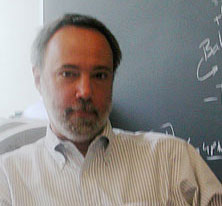New Technologies for Measuring Neural Circuit Dynamics
 At the microscopic scale, the brain consists of vast networks of neurons that are wired together with synaptic connections to form neural circuits. Neurons are individuals, in that each neuron can have electrical and chemical activity that is different from that of its neighbors. But the activity of each neuron is also dependent on that of the others in the circuit, through the synaptic connections that define the circuit’s architecture. A thinking brain can therefore be viewed as an immensely complex pattern of activity distributed across the circuit. As different neurons become silent or active, the pattern of activity shifts in space and time. These shifting patterns define what is known as neural circuit dynamics. The key to understanding how the brain works is to determine how the neural dynamics across these vast networks represent and process information relevant to behavior. Huge technical challenges exist in performing measurements of neural circuit dynamics in the awake brain. This talk will present recent advances in methods and instrumentation that combine genetically encoded molecular sensors, optical imaging, and virtual reality systems to measure neural circuit dynamics in the mouse brain during virtual navigation and decision-making.
At the microscopic scale, the brain consists of vast networks of neurons that are wired together with synaptic connections to form neural circuits. Neurons are individuals, in that each neuron can have electrical and chemical activity that is different from that of its neighbors. But the activity of each neuron is also dependent on that of the others in the circuit, through the synaptic connections that define the circuit’s architecture. A thinking brain can therefore be viewed as an immensely complex pattern of activity distributed across the circuit. As different neurons become silent or active, the pattern of activity shifts in space and time. These shifting patterns define what is known as neural circuit dynamics. The key to understanding how the brain works is to determine how the neural dynamics across these vast networks represent and process information relevant to behavior. Huge technical challenges exist in performing measurements of neural circuit dynamics in the awake brain. This talk will present recent advances in methods and instrumentation that combine genetically encoded molecular sensors, optical imaging, and virtual reality systems to measure neural circuit dynamics in the mouse brain during virtual navigation and decision-making.
About the Speaker:
David Tank is the Henry L. Hillman professor of neuroscience and molecular biology at Princeton University and Co-Director of the Princeton Neuroscience Institute. He also directs the Bezos Center for Neural Circuit Dynamics.
Dr. Tank earned his B.S. in Physics and Mathematics at Case Western Reserve University in 1976 and a Ph.D. degree in Physics from Cornell University in 1983. From 1983-2001 he was a research scientist at Bell Laboratories in Murray Hill, NJ, and became a Bell Laboratories Fellow in 1999. From 1991-2001 he served as Department Head of the Biological Computation Research Department. In 2001, he moved to Princeton University, becoming a founding Co-Director of the Princeton Neuroscience Institute in 2005. His research interests include the measurement, analysis, and modeling of neural circuit dynamics. At Bell Laboratories he contributed to the development of attractor network models of neural decision-making, the development of functional MRI imaging, and the development of cellular resolution optical imaging of neural dynamics. More recently, his work has focused on the mechanisms of persistent neural activity and the development and application of rodent virtual reality systems combined with optical imaging and electrophysiology to study neural circuit dynamics during navigation.
Dr. Tank has received several awards and honors for his research including election to the National Academy of Sciences and the American Academy of Arts and Sciences. He is a fellow of the American Physical Society and a recipient of the W. Alden Spencer Award from Columbia University and the Lawrence Katz Prize from Duke University.


